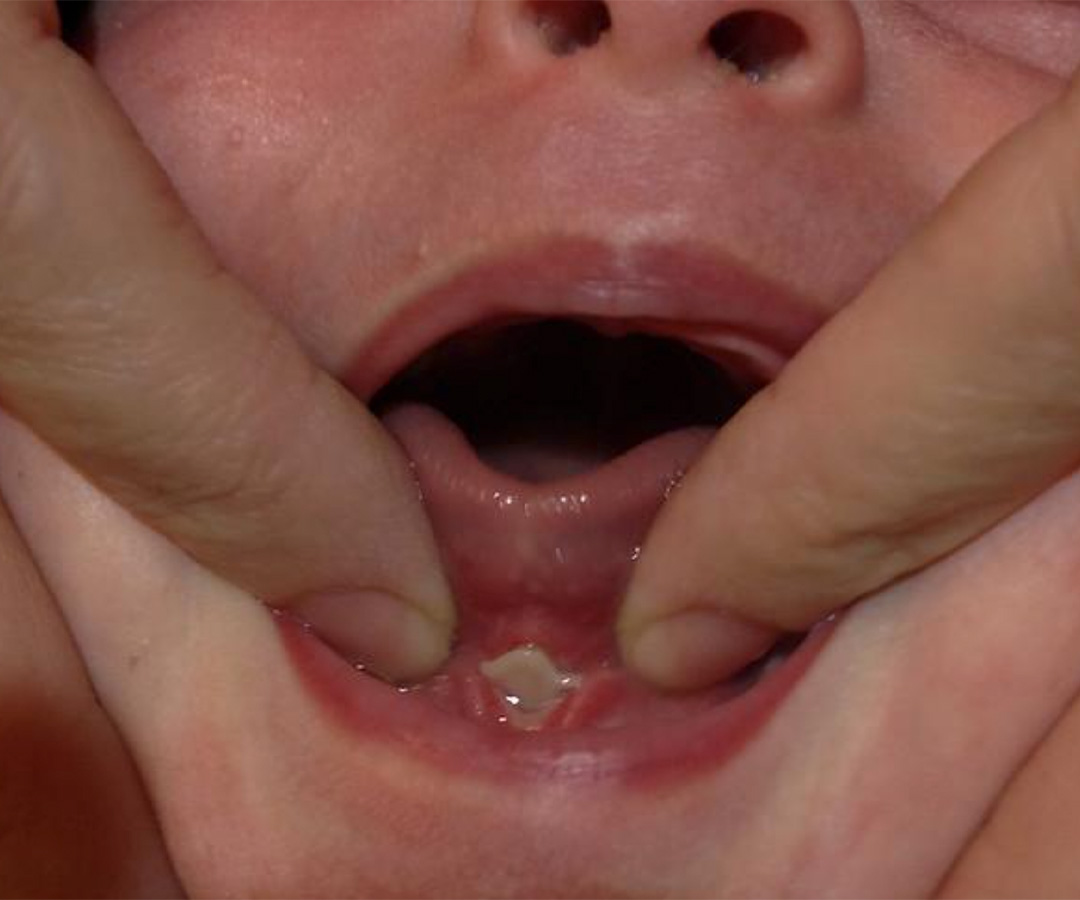Post-Op Instructions & FAQ
Please read our post-op instructions for laser tongue-tie release and browse our list of frequently asked questions. For further information, consult with our pediatric tongue-tie dentist in Okemos, MI.
What to Expect After the Procedure
After tongue-tie treatment is complete, we encourage parents to feed their baby, either from the breast or bottle. Most breastfeeding mothers immediately notice an improvement in their baby’s latch and the amount of pain in the breast and nipple.
It is strongly recommended that all breastfeeding mothers follow up with their lactation specialist or doula as soon as possible after treatment to help the baby learn to effectively breastfeed with their newfound tongue and lip mobility.

Post-Operative Stretches & Healing
It is extremely important to keep your child well hydrated during post-operative care by means of breastfeeding, bottle feeding, SNS, finger feeding, or giving plenty of fluids.
If your child refuses to feed, call Dr. Ramaswami immediately or the emergency number listed on your discharge sheet.
Doing the exercises as instructed allows for proper healing by reducing the risk of re-attachment and therefore the possibility of repeat surgery.
Exercises must be done 5-6 times a day for 4 weeks. (IMPORTANT: Do exercises only once the day of the procedure.)
Make sure that your hands are clean and your fingernails are short. Wash hands for 2 minutes.
Your child may cry or fuss during the exercises but should calm down quickly once completed.
Healing
After the , there will be a diamond-shaped wound under your child’s tongue and/or lip. It takes about 2 weeks for the wound to heal (sometimes a bit longer). The healing will begin almost immediately after treatment, and the wound will often be larger than you would expect. The wound will be whitish yellow and will look similar to pus. This is normal!
There are two important concepts to understand about oral wounds:
Any open oral wound likes to contract towards the center of that wound as it is healing. Hence the need to keep it dilated open.
If you have two raw surfaces in the mouth in close proximity, they will reattach.
The purpose of the exercises is to ensure that a new frenum heals with increased flexibility. I highly encourage you to approach these exercises in a positive manner. Your technique AND positive demeanor are equally important.

A normal healing lingual (tongue) tongue-tie release. Source: Dr. Bobby Ghaheri
Positioning
The best position for stretching your baby’s lip and tongue is to have their head against your belly. If your child’s head is a clock, you should be standing at 12 clock position to see inside your baby’s mouth. It is more difficult to do the stretches if your baby’s feet are pointing towards you.
Stretches
Do one stretch on the evening of the surgery. Then, do one overnight stretch. Starting the next morning, lift the tongue every 4 hours during the day. Do not exceed 6 hours between overnight stretches. Repeat this for the first 3-4 weeks after the procedure.
There may be a few drops of blood as the area stretches which is normal. Breastfeeding may stop the bleeding. If bleeding continues, apply pressure to the wound with a gauze pad for 5-10 minutes. If bleeding continues, press and don’t peek for 20 minutes. A moistened dark tea bag can be used instead of gauze.
The Upper Lip
The upper lip is the easier of the two sites to stretch. If you must stretch both sites, I recommend that you start with the lip. Typically, babies don’t like either of the stretches and may cry, so starting with the lip allows you to get under the tongue easier once the baby starts to cry.
For the upper lip, simply place your finger under the lip and move it up as high as it will go (until it bumps into resistance) and hold for 2-3 seconds.
Then gently sweep from side to side, as if you were brushing invisible teeth, for about 5 seconds. Remember, the main goal of this procedure is to insert your finger between the raw, opposing surfaces of the lip and the gum so they can’t stick together.

The Tongue
To stretch the tongue, insert both index fingers into the mouth (insert one in the mouth and go towards the cheek to stretch out the mouth, making room for your other index finger). Then use both index fingers to dive under the tongue and pick it up, towards the roof of the baby’s mouth.
The tongue needs three separate stretching motions—height, width, and depth—to minimize reattachment.
Instructions for Tongue Exercises
With clean hands, press down on the baby’s chin to gently open the mouth.
While the baby’s mouth is open, use one or two fingers from the other hand to tuck under the baby’s tongue and gently lift it upwards and back, exposing the healing diamond-shaped wound.
Hold this position for no more than 3 seconds.
You may gently massage the wound to make sure it feels soft and squishy. DO NOT RUB HARD!
Please take a look at the following video from Dr. Ghaheri who demonstrates how to do the stretches.
If you are concerned with re-attachment, please call our office so Dr. Ramaswami can do a release of the adhesions. It is normal for the wound to contract during healing and re-attach. However, while re-attaching, we want it to still provide the same mobility for the tongue and not restrict its movement.
Release of adhesions is a technique that is demonstrated by Dr. Richard Baxter, in this video. When the adhesions break, there will be bleeding, and the wound will open up.
Suck Training
It is important to work on suck training and tongue strength with your child within a few days of the procedure. You do not need to start immediately but give them 3-4 days to allow the discomfort to pass, then begin a few times a day. Your IBCLC is the best resource for knowing which exercises will best benefit your child. Here are some videos that show some tongue strengthening exercises.
FAQ
Yes, we highly encourage you to nurse your baby or feed your baby right after the procedure with lots of cuddles and skin-to-skin contact.
Every baby is different. Discomfort is mainly from inflammation. Inflammation is at peak 48-72 hours after the procedure. Keeping the child comfortable with Tylenol or ibuprofen will ensure your child is less uncomfortable.
Your baby/child will fuss even after the first 3 days, as they do not want anyone to be touching their mouth. There are even some babies who act as if nothing happened at all and don’t seem to be in any discomfort. Treat your baby based on how he or she is acting.
For the first three days (especially the first 24 hours), please time the Tylenol so the baby has the medication on board 30 minutes prior to feeding or stretching so they are not in discomfort.
Our CO2 laser is state of the art, and has been shown to produce less inflammation compared to other wavelengths of lasers.
If your baby is in pain and is not due for pain medication any time soon, try giving lots of cuddles and skin-to skin-contact. Use the sterile syringe that is in your post-op care packet, fill it with breastmilk, freeze, and de-freeze icicles. Then, squirt them gently on the wound after stretching.
Breast milk ice chips/slushes can help with pain, too. Babywear as much as possible, if you can. Human touch releases oxytocin, which lowers pain levels.
Please note that babies are able to sense their mothers’ stress and anxiety. If you are finding yourself upset and crying over your baby’s distress, hand them over to another caregiver or put them down and take a few minutes to relax and compose yourself.
Successful breastfeeding is a team approach. Most often, mothers may see an improvement in deeper latch, less nipple pain, and more milk transfer. However, it is important to understand that the surgical procedure of releasing the tongue tie is only one piece of the puzzle. Following up with a lactation specialist who is knowledgeable in tongue tie procedures is important.
If Dr. Ramaswami indicates that your baby should see an osteopathic doctor, feeding specialist, or an occupational therapist, it is important to follow through with a referral after the procedure. Research has shown successful breastfeeding to be established when there is a team approach to feeding problems in babies.
Many of the infants we evaluate present with plagiocephaly (flattened head) or torticollis (twisted neck). More than likely, if these issues are present during the initial evaluation, osteopathic functional manual medicine and physical therapy is recommended to continue after the post-tongue-tie release phase of treatment to establish successful feeding.
Many infants that have have other physical issues such as these due to how they were positioned in the uterus and may need unwinding after the delivery.
Book a Lip & Tongue-Tie Consultation
Our pediatric tongue-tie dentist in Okemos, MI, is accepting new patients. To schedule an appointment, please call the Michigan Tongue-Tie & Airway Center at (517) 574-4688 or fill out our online contact form.

